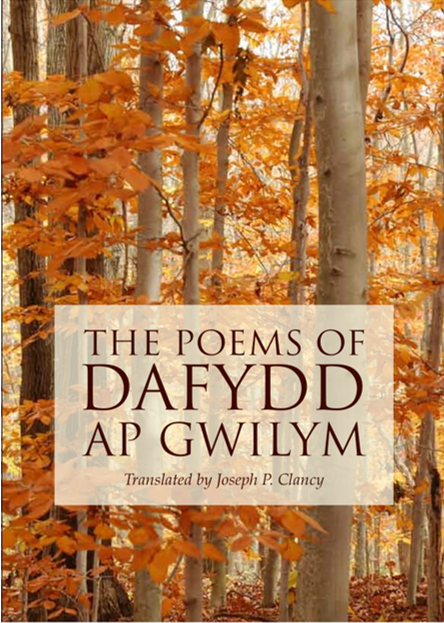On 18 October, 2016, the Centre for Scottish and Celtic Studies welcomed our own Thomas Clancy, Professor of Celtic at the University of Glasgow, to discuss ‘Sequencing Dafydd ap Gwilym.’ He began by saying that this lecture was largely the result of thoughts that arose while editing his father’s most recent book, The Poems of Dafydd Ap Gwilym. Professor Joseph P. Clancy has translated many works of Welsh literature into English dating from the medieval to the modern period, including Medieval Welsh Lyrics and The Odes and Epodes of Horace. This most recent work concerning the poetry of Dafydd Ap Gwilym explores a possible sequence for his poetry and how this might reflect Dafydd’s evolution as a poet. In this lecture, Thomas Clancy discussed the methodological concerns involved with sequencing this particular collection of poetry and explained how even the attempt can offer new insights in understanding the verse and the poet who composed them.
Dafydd ap Gwilym was a poet who wrote in Wales sometime during the 14th century AD. He is best known for his innovation of the Cywydd metre (which consists of couplets of seven syllable lines and takes the form of more informal poetry as opposed to praise for an individual or patron), and who was known for writing on the subject of romantic love, but in a way that makes fun of a poet who is unlucky in love (specifically Dafydd himself).
Thomas explained that sequencing Dafydd’s poetry is particularly difficult because there are very few events or people mentioned that can be attributed to a specific date. Although Dafydd had written a number of elegies for his patrons and other poets, there is evidence to suggest that some of these may have been “mock elegies”, or a humorous elegy created during the lifetime of the person. In some cases, poets would write these for each other; in these cases it is obvious that at least one of the elegies was written during a poet’s lifetime, as both poets could not be dead. Therefore, even if researchers know the date of death for the subject of one of Dafydd’s elegies, it is uncertain whether they were actually deceased at the time of his writing.
A few poems are datable as they post-date specific events in the lives of certain individuals, such as when the individual became constable or when they were incarcerated for a specific crime. These poems are very few in number and largely date to sometime between 1340 and 1352. However, given the amount of poetry Dafydd has written, it is likely that he had composed poetry for a much longer period of time than fifteen years. A poem entitled Y Cloc (“The Clock”), if it was actually written by Dafydd, could be the latest dateable poem he had written, as there is no record of a clock in Britain before the 1370s.
Due to the scarcity of reliable dates cited in Dafydd’s work, Thomas suggested that a productive way of sequencing the poetry of Dafydd ap Gwilym was by “sequencing the sequences.” He stated that there were some groups of poetry that were clearly related to each other, either due to the presence of recurring characters or the use of specific phrases. One individual who was the object of Dafydd’s affection for an extensive period was “Morfudd”. Dafydd wrote many poems about Morfudd, apparently throughout her lifetime; some indicate that she is unmarried, some where she is betrothed, at least one where she is clearly married and pregnant, some where she is married with children, and others where she or Dafydd seem to be older. There are other specific women mentioned in several poems, Dyddgu and a noblewoman referred to as “The Girl from Gwynedd.” Morfudd is also mentioned in some of these works; how Morfudd is described can indicate when these works were composed. In this way, a relative, although subjective, chronology for some of Dafydd’s poetry can be created.
Thomas concluded by stating that anyone who has studied Dafydd ap Gwilym has their own ideas about how his work should be sequenced. Although it is a subjective approach, each attempt at sequencing brings out new insights into Dafydd’s poetry. While it is a useful researcher’s tool, sequencing is not necessary to enjoy the poetry as each poem is a work of art in its own right.
Professor Joseph P. Clancy’s book The Poems of Dafydd Ap Gwilym was published on 31 May 2016 and is available for purchase in paperback or ebook format from Gwales.com or Amazon for a RRP of £17.50 (plus postage). For more on the translator and his work, see his webpage here.
Summary by Megan Kasten (PhD Researcher)
Our seminar series continues on Wednesday 26 October 2016 with Claire Hawes (Aberdeen) to discuss ‘Politics and the Public Domain in the Later Fifteenth Century.’ This will be held in Room 202, 3 University Gardens at 5.30pm.


